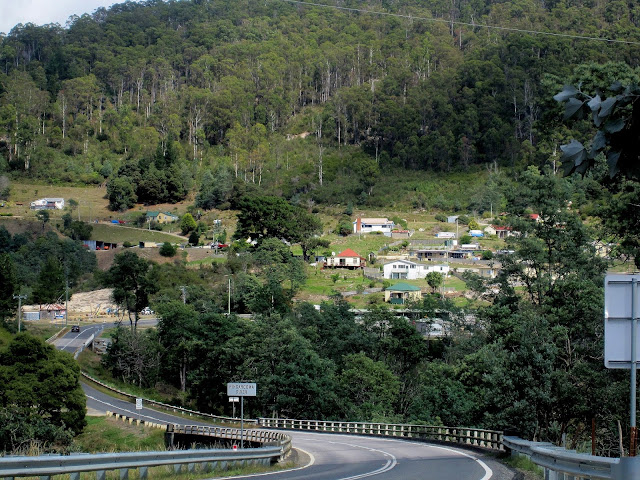 |
| First glimpse of Derby, pronounced Derby, not Darby |
Resisting the urge to travel over yet another unmade road -
mileage unknown, to the state’s most northerly point – Cape Portland, I headed
south east through two more former mining towns, Gladstone and Pioneer, which
have not yet capitalised on their tourist potential. To be fair, Pioneer did have BBQ
facilities on top of the hill, and Derby, which I visited next, looked much like
this the last time I saw it almost two decades ago. Their importance should not
be underestimated either. Not only did such small towns contribute enormously
to the wealth of the infant colonies and permit them to forget their convict
origins and forge a nation, but they led the way out of depression and a life of rural servitude,
greatly improving the lot of most people’s lives .
Although known since the Bronze Age and mined in small
quantities for rustproofing tools, weapons and kitchen utensils, production of tin really escalated in the late C18th. with
the invention and widespread adoption of canning for the preservation food.
This was in great demand by the French, Dutch and British navies since it
enabled men to remain at sea for much longer periods. According to Sue Shephard, author of Pickled,
Potted and Canned quoted in
fascinating account on this topic in in the Seven Years' War
in the 1750s, died of malnutrition.” As Geoghegan writes “Supplied to the Royal
Navy in 1813, they (cans) changed warfare and, later, exploration and diets.”
 |
| Main Street, Derby looking west |
Though I can't find specific proof, I am fairly certain that colonial demand for vast quantities of cheap roofing and fencing material which tin was able to provide, would also have contributed, as would as would the making of machinery and eventually car parts. Since demand was particularly high during wartime, I assume that it was also used in the manufacture of planes and weapons. Tin was also used in the making of plate glass, another burgeoning industry, for bells and musical instruments, and for soldering of plumbing and electrical components.
Although 50% per cent of cans are still made from tin and it is still a major component in the manufacture of cars and electronic goods such as ipads and iphones, several events conspired to render these little villages obsolete. Where the mines were not completely worked out, competition came in the form of the discovery of large deposits in other countries such as Bolivia and Malaysia and, “(w)ithin half a century of the tin boom of 1870-72, the industry was almost dead in the face of foreign competition.”
 |
| Derby's modest architecture is frozen in time |
The final blow for many mines came in 1985, when the
International Tin Council which guaranteed prices for suppliers, collapsed and
returns fell to below the cost of production, resulting in the closure of almost
all tin mines in Tasmania, with the exception of Renison Bell on the West Coast. Today most of the world's tin comes from China or
Indonesia, with small amounts still being mined in Bolivia, Australia and Peru.
 |
| Small galleries and coffee shops abound |
There, I bet you weren't expecting all that. That's what happens when you start wondering why is this place here? And then what happened? But I digress. Derby
(pronounced DERBY, not Darby as you might expect, though it does have an
popular Derby Day, pronounced Darby in October), provides a startling contrast.
Its Briseis* Mine was one of the largest tin mines in the world from the late C19th to 1930 and supported around three
thousand people.
*Named after the 1876 Melbourne Cup winner, in case you were
wondering.
Though the population had fallen or grown to 208 in 2011, and
the town was almost deserted the last
time I came, I now had great difficulty getting a parking spot on the main
street which positively bristles with small shops, cafes and of course, one
or two large pubs. Its architecture now attractively restored and painted, remains frozen in time and though
it never reached the grand heights of say, the Empire Hotel in Queenstown or
the Gaiety Theatre in Zeehan, what it lacks in grandeur it makes up for in charm.
There’s a museum in the old schoolhouse and a new one - “The Tin Dragon Interpretation
Centre, " set down below the main
street, which pays tribute to those who lost their lives in Derby’s great flood
and the many Chinese workers who came. It was lovely to see this little town
all spruced up and buzzing.
 |
| Museum in the old School |
 |
| Looking out from the tunnel |
From there I travelled west through Scottsdale, (population 2461),
the largest town in the North East and definitely its service centre – Eureka, I even had
a signal on my phone, though I didn’t linger long. Instead, I turned west to
Lilydale where there was another waterfall marked on my map.



Comments